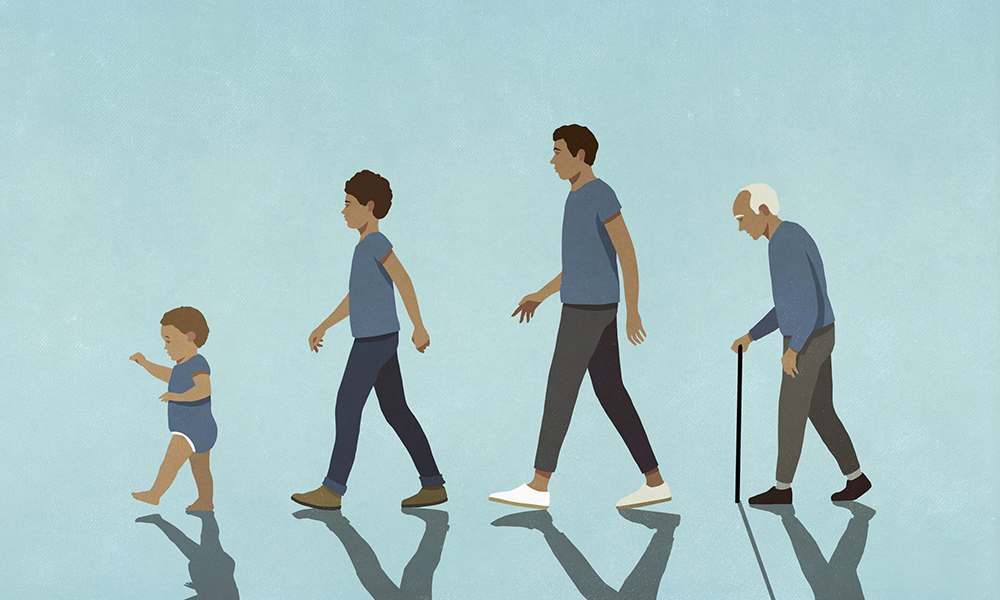
到本世纪末,全球人口的预期寿命都将延长,这对希望花更多时间陪伴孙辈的祖父母和曾祖父母来说是一个好消息。
然而,坏消息是:他们可能会因为年老体弱而无法看护孙辈,甚至自己也需要看护。
一个国际研究小组对2022年联合国(United Nations)的《世界人口展望》(World Population Prospects)的历史和预测数据进行了分析。他们最近发表在《美国国家科学院院刊》(Proceedings of the National Academy of Sciences)上的一项研究发现:到2095年,由于生育率降低和生育年龄推迟,全球人均在世家庭成员数量将大幅下降——降幅接近40%。
1950年,一名65岁的女性可能有41名在世家庭成员。研究人员得出以下结论:到2095年,一名65岁的女性预计只有25名在世亲属。
虽然未来家庭规模将横向缩小——表兄弟姐妹、侄女、侄子和孙子孙女的数量会减少,但由于预期寿命延长,预计家庭规模将实现纵向扩大。然而,年长的祖父母和曾祖父母可能“年老体弱”,无法为孙辈提供看护支持。
预计南美洲和加勒比地区的家庭规模降幅最大。研究人员表示,北美和欧洲的家庭规模已经呈缩小趋势,因此这些地区的家庭规模缩减幅度不会那么明显。
德国罗斯托克的马克斯·普朗克人口研究所(Max Planck Institute for Demographic Research)的亲属关系不平等研究小组的负责人迭戈·阿尔布雷兹-古铁雷斯在一份有关该研究的新闻稿中说:“我们的研究结果证实,全球范围内亲属关系资源的可得性正在下降。”
他补充道:“随着个人与其亲属之间年龄差距的拉大,人们的家庭网络不仅会呈小型化趋势,而且会呈老龄化趋势。虽然这在理论上有助于减轻父母的育儿负担,但(曾)祖父母实际上可能自己也需要看护。”
新冠疫情后美国人的预期寿命没有反弹
在新发现出炉之际,美国人的预期寿命持续下降,与世界上许多其他国家形成对比。2021年,美国人的预期寿命(76.1岁)连续第二年下降。2019年为78.8岁,2020年为77岁。
根据2023年11月发表在《美国医学会杂志-内科学纪要》(JAMA Internal Medicine)上的一份研究通讯,由于新冠肺炎死亡率和“绝望和枪支暴力导致的双重死亡危机”,美国女性和男性的预期寿命差距在2021年也扩大到了近6年,达到了近20年来的最高水平。
据美国外交关系协会(Council on Foreign Relations)称,虽然美国在医疗保健方面的支出高于任何发达国家,但在预期寿命方面却排名垫底。虽然在新冠疫情期间全球预期寿命都受到了冲击,但许多国家的预期寿命都有所反弹,美国再次成为例外。在经济合作与发展组织(Organization for Economic Cooperation and Development)成员国中,美国在接种全系列疫苗预防新冠的人口比例方面排名接近垫底。(财富中文网)
译者:中慧言-王芳
到本世纪末,全球人口的预期寿命都将延长,这对希望花更多时间陪伴孙辈的祖父母和曾祖父母来说是一个好消息。
然而,坏消息是:他们可能会因为年老体弱而无法看护孙辈,甚至自己也需要看护。
一个国际研究小组对2022年联合国(United Nations)的《世界人口展望》(World Population Prospects)的历史和预测数据进行了分析。他们最近发表在《美国国家科学院院刊》(Proceedings of the National Academy of Sciences)上的一项研究发现:到2095年,由于生育率降低和生育年龄推迟,全球人均在世家庭成员数量将大幅下降——降幅接近40%。
1950年,一名65岁的女性可能有41名在世家庭成员。研究人员得出以下结论:到2095年,一名65岁的女性预计只有25名在世亲属。
虽然未来家庭规模将横向缩小——表兄弟姐妹、侄女、侄子和孙子孙女的数量会减少,但由于预期寿命延长,预计家庭规模将实现纵向扩大。然而,年长的祖父母和曾祖父母可能“年老体弱”,无法为孙辈提供看护支持。
预计南美洲和加勒比地区的家庭规模降幅最大。研究人员表示,北美和欧洲的家庭规模已经呈缩小趋势,因此这些地区的家庭规模缩减幅度不会那么明显。
德国罗斯托克的马克斯·普朗克人口研究所(Max Planck Institute for Demographic Research)的亲属关系不平等研究小组的负责人迭戈·阿尔布雷兹-古铁雷斯在一份有关该研究的新闻稿中说:“我们的研究结果证实,全球范围内亲属关系资源的可得性正在下降。”
他补充道:“随着个人与其亲属之间年龄差距的拉大,人们的家庭网络不仅会呈小型化趋势,而且会呈老龄化趋势。虽然这在理论上有助于减轻父母的育儿负担,但(曾)祖父母实际上可能自己也需要看护。”
新冠疫情后美国人的预期寿命没有反弹
在新发现出炉之际,美国人的预期寿命持续下降,与世界上许多其他国家形成对比。2021年,美国人的预期寿命(76.1岁)连续第二年下降。2019年为78.8岁,2020年为77岁。
根据2023年11月发表在《美国医学会杂志-内科学纪要》(JAMA Internal Medicine)上的一份研究通讯,由于新冠肺炎死亡率和“绝望和枪支暴力导致的双重死亡危机”,美国女性和男性的预期寿命差距在2021年也扩大到了近6年,达到了近20年来的最高水平。
据美国外交关系协会(Council on Foreign Relations)称,虽然美国在医疗保健方面的支出高于任何发达国家,但在预期寿命方面却排名垫底。虽然在新冠疫情期间全球预期寿命都受到了冲击,但许多国家的预期寿命都有所反弹,美国再次成为例外。在经济合作与发展组织(Organization for Economic Cooperation and Development)成员国中,美国在接种全系列疫苗预防新冠的人口比例方面排名接近垫底。(财富中文网)
译者:中慧言-王芳
Life expectancy should increase globally by the end of the century—good news for grandparents and great-grandparents looking to spend more time with their grandchildren.
The bad news: They may be too old and frail to help with caregiving—and even require caregiving themselves.
An international team of researchers crunched both historical and projected numbers from the 2022 United Nations’ World Population Prospects. Among their findings, published recently in the journal Proceedings of the National Academy of Sciences: The number of living family members each person has will decline dramatically worldwide—by nearly 40%—by 2095 owing to lower and later fertility.
In 1950, a 65-year-old woman could expect to have 41 living family members. In 2095, a 65-year-old woman is projected to have only 25 living relatives, researchers determined.
While families will shrink horizontally—with fewer cousins, nieces, nephews, and grandchildren—they’re expected to grow vertically thanks to longer life expectancies. Older grandparents and great-grandparents, however, might be “too old and frail” to provide caregiving support to grandchildren.
The largest family size declines are expected in South America and the Caribbean. North American and European families already trend smaller, so shrinkage will be less pronounced in those regions, according to researchers.
“Our findings confirm that the availability of kinship resources is declining worldwide,” Diego Alburez-Gutierrez—head of the research group on kinship inequalities at the Max Planck Institute for Demographic Research in Rostock, Germany—said in a news release about the study.
“As the age gap between individuals and their relatives widens, people will have family networks that are not just smaller, but also older,” he added. “While this could theoretically help ease the burden of childcare for parents, these (great-)grandparents may actually need care themselves.”
Post-pandemic life expectancy not bouncing back in U.S.
The new findings come as life expectancy in the U.S. continues to fall, in contrast with much of the rest of the world. In 2021, life expectancy—76.1 years—decreased for a second consecutive year. It sat at 78.8 years in 2019 and 77 years in 2020.
The gap in life expectancy between U.S. women and men widened in 2021, too, to nearly six years—reaching a near two-decade high owing to COVID mortality and “twin crises of deaths from despair and firearm violence,” according to a research letter published in November in the journal JAMA Internal Medicine.
While the U.S. spends more than any developed nation on health care, it ranks near the bottom when it comes to life expectancy, according to the Council on Foreign Relations. While life expectancy took a hit globally during the COVID-19 pandemic, it rebounded in many countries, with the U.S. again serving as an outlier. It ranks near the bottom of a list of Organization for Economic Cooperation and Development countries when it comes to the percentage of its population fully vaccinated against disease.






